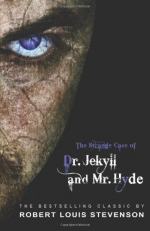|
|
Dr. Jekyll and Mr. Hyde Topic Tracking: Evil
Chapter 1
Evil 1: From the beginning of the story, there is a contrast between Mr. Utterson's straight-laced, upright character and his interesting tolerance for the immoral behavior of some of his friends. Such a protagonist is called upon to "solve" or reveal the evil of Hyde.
Chapter 2
Evil 2: Mr. Utterson is convinced that if he can catch a glimpse of Hyde, many questions can be answered. When he first lays eyes on Hyde, Mr. Utterson is repulsed. He likens Hyde's appearance to Satan, verifying Mr. Enfield's description that there is something sinister about the young man.
Chapter 4
Evil 3: A maid witnesses Hyde commit a murder by clubbing an elderly gentleman to death. As the story progresses, Hyde's crime become more pronounced. He goes from injuring a little girl to killing an old man, seemingly without any conscience.
Chapter 8
Evil 4: Poole feels strongly that the person he saw was Hyde. Mr. Utterson agrees with the assessment, acknowledging that he too had a feeling about the sinister connection between Dr. Jekyll and Mr. Hyde. Mr. Utterson believes that Hyde has come to kill Dr. Jekyll.
Chapter 9
Evil 5: Hyde is the manifestation of Dr. Jekyll's evil side, but the incident at Dr. Lanyon's house shows how interconnected Dr. Jekyll and Hyde are. The Dr. Jekyll side allows Hyde to transform, almost as if to show off in front of Dr. Lanyon. The sinister side is present in both Hyde and Dr. Jekyll.
Chapter 10
Evil 6: When Dr. Jekyll drinks from his invention, he feels transformed. Dr. Jekyll conjectures that Hyde is smaller because the evil side of him is less developed. He also believes the evil side is more natural to the human being. Dr. Jekyll concludes that everyone is made up of both good and evil. Hyde, alone in mankind, is pure evil.




